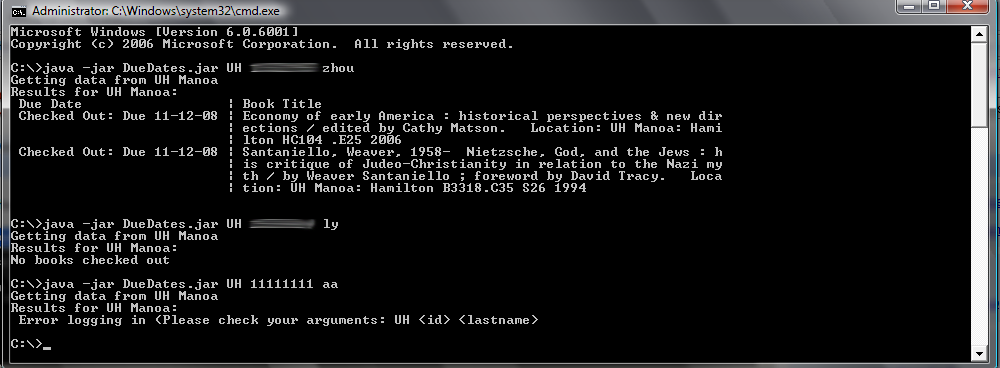DueDates 2.0 takes our previous DueDates 1.2 and basically puts it in a web application using Wicket and Jetty. Sure it sounds easy. But it was a rough experience for me since I don't have a strong dynamic web background. Now that it's done, I feel good about it. All this Java background we accumulated in the ICS program is finally being put on display.... to something NOT LAME.
Release 2.0 was assigned new groups and I was grouped in Team Ahinahina together
- Phillip Ka Hung Lau
- Scheller Sanchez
- Robin Sanchez
Project Status & Process:

Our project was nearly complete. Nearly everything is working except the "within" feature for each individual library. We couldn't figure out how to uniquely identify the textfield for each library. We also forgot to allow the project to sort by book title. But that is something similar to the other sort methods. Unfortunately, it's getting late and everyone has other assignments to work on. So we have no choice but to leave the project as it is. Finally, we forgot to include a "within" on the Alerts Page.
We met nearly every other day in the first week and Sinclair library. But after falling behind schedule, we met close to everyday the second week. There were times where I'd spend more time at Sinclair than I did at home. A couple of times, some of us spent 12-13 hours at the library. That's dedication..... God I need sleep.
 We tried to divide the task up evenly in the first week, but some of us fell behind. So the rest of us had to pick up the slack. It was frustrating early on. But they were more than willing to take additional responsibility to make up for it in the end. If I could change something, I wish we set firm progress points. It felt like a lot was crammed into the last week.
We tried to divide the task up evenly in the first week, but some of us fell behind. So the rest of us had to pick up the slack. It was frustrating early on. But they were more than willing to take additional responsibility to make up for it in the end. If I could change something, I wish we set firm progress points. It felt like a lot was crammed into the last week.My Responsibilities
I was responsible for the Login (Index) page and some of the Display Page features. We wanted to add secure authentication. But we weren't sure if we would finish in time, so we decided to simply get it to work first. On the display page, I worked closely with Robin looking over the system requirements trying to get an understanding of what features needed to be implemented. I populated the table and applies some aesthetics to the boring HTML table that was originally there. I also worked closely with Robin to dynamically create the individual "Update" buttons for each library.
The difficulty with the Update buttons is, how do we identify which button is clicked if they are populated dynamically based on a list? The wicket ID is the same because we only specify how to populate each row. Fortunately when a button is added, it is basically creating a Button class on the fly and adding it to the page. I ended up creating a String variable within each Button class, and that helped identify which button is which.
It really helped bouncing ideas off one another. My team member's idea can inspire an idea in me. And my ideas can inspire them.
Differences in DueDates 2.0 versus Prior Releases:
This was definitely more difficult. We're still new to the Wicket classes so it was challenging trying to working with dynamic objects. I think it just takes practice. I still have a lot to learn with Wicket. I found myself constantly going between the HTML and the Java files because I forgot the model hierarchy.
Surprisingly with this release and larger group, I was able to meet more often. I suppose it just depends on everyone's schedule. Everyone had the same habit of staying up late. It was harder dividing the tasks evenly and keeping track of everything however. With tasks divided between more people, we had to constantly check on who's doing what. Is that person's task too difficult? Is that person's task too simple? Does everyone have a task to work on?
The Learning Experience:
Continuous integration was extremely helpful and prevented a lot of bugs this time. With so many files and commits, there were bound to be a lot of mistakes, uncommented code, etc. The software ICU however was a pain. I felt it didn't completely reflect our efforts. The commits on some days were insanely high for some of us. I am pretty sure we did not commit that many times in one day.
Testing/Coverage was low most of the time because we couldn't figure out how to test the application without comitting any accounts. It was our fault for not asking if Hudson had a duedates.xml file (like the users need to have). We constantly tested our applications by running it and logging in ourselves. In the end, I modified the program to look inside the project's directory for a duedates.xml if a ~user/.duedates/duedates.xml did not exist.
I think things could be improved. I think I could be more vocal next time around. I don't think I started too late, but there were some questions I could have asked earlier that would have simplify things. I thought I could have kindly offered my help (in a non-intrusive way) to see who's falling behind. I did work with Robin quite a bit. I thought our collaborations were pretty good. We got a lot of work done. I need to build on that.
DueDates-Ahinahina 2.0 - [Project-Home]






